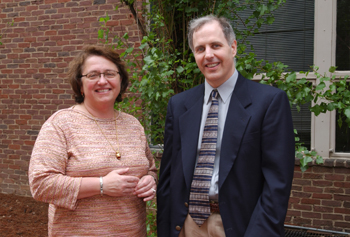
Margaret Pericak-Vance, Ph.D., left, director of the Duke Center for Human Genetics, and Jonathan Haines, Ph.D., director of the Vanderbilt Center for Human Genetics Research, are collaborating on the search for genes involved in Alzheimer's disease. Photo by Anne Rayner
Vanderbilt, Duke scientists discover genetic clues to development of Alzheimers
Unraveling the genetic determinants of complex diseases requires new techniques and “out-of-the-box” thinking, Duke University medical geneticist Margaret Pericak-Vance, Ph.D., said last week during a symposium at Vanderbilt.
Pericak-Vance, who directs the Duke Center for Human Genetics, cited her collaboration with Jonathan Haines, Ph.D., T.H. Morgan Professor of Human Genetics at Vanderbilt, which has led to new understanding of Alzheimer’s disease.
Rather than focusing on the risk of developing Alzheimer’s disease, the researchers decided to look for “age at onset” genes, which influence when the disorder strikes. To increase their chances of finding their “needle” in the human genomic “haystack,” they used a new technique they call “genomic convergence,” which combines three independent lines of genetic evidence.
Last fall they reported the identification of a specific gene, called GST01, that is significantly associated with the late onset of Alzheimer’s disease. While the gene does not increase risk, understanding how “onset” is regulated may make it possible to delay the development of the disease. The discovery also illustrates how “progress can be made as long as you’re creative,” Pericak-Vance said.
Pericak-Vance was the keynote speaker during the symposium, which celebrated the recent establishment of the Vanderbilt Center for Human Genetics Research. Haines directs the center, a collaborative research environment accessible to all Vanderbilt faculty, that he said aims to “dissect the genetic underpinnings of human traits.”
The sequencing of the human genome, and equally “incredible” progress in software technology has dramatically increased the ability of researchers to cull through the billions of base pairs – looking for mutations that could contribute to disease, Haines said. It’s still a bit like looking for needles in a haystack, “but it’s now manageable,” he said.
To speed the research, Jason Moore, Ph.D., and his colleagues at Vanderbilt have developed methods that enable them to separate the highest risk combinations from those at the lowest risk, and models that enable them to predict gene-gene interactions. “We’re not saying this is what the biological system looks like, but we’re hoping … to generate hypotheses about how they function,” said Moore, associate professor of Molecular Physiology & Biophysics.
Marshall Summar, M.D., associate professor of Pediatrics and Molecular Physiology & Biophysics at Vanderbilt, described how genetic and environmental factors interact to produce illness, and how the factors can be altered to “push back the threshold” and prevent, or reduce the severity, of illness.
For example, understanding how to intervene in the urea cycle, which among other things produces the potent vasodilator nitric oxide, could lead to ways to prevent pulmonary hypertension after cardiac surgery, he said.













